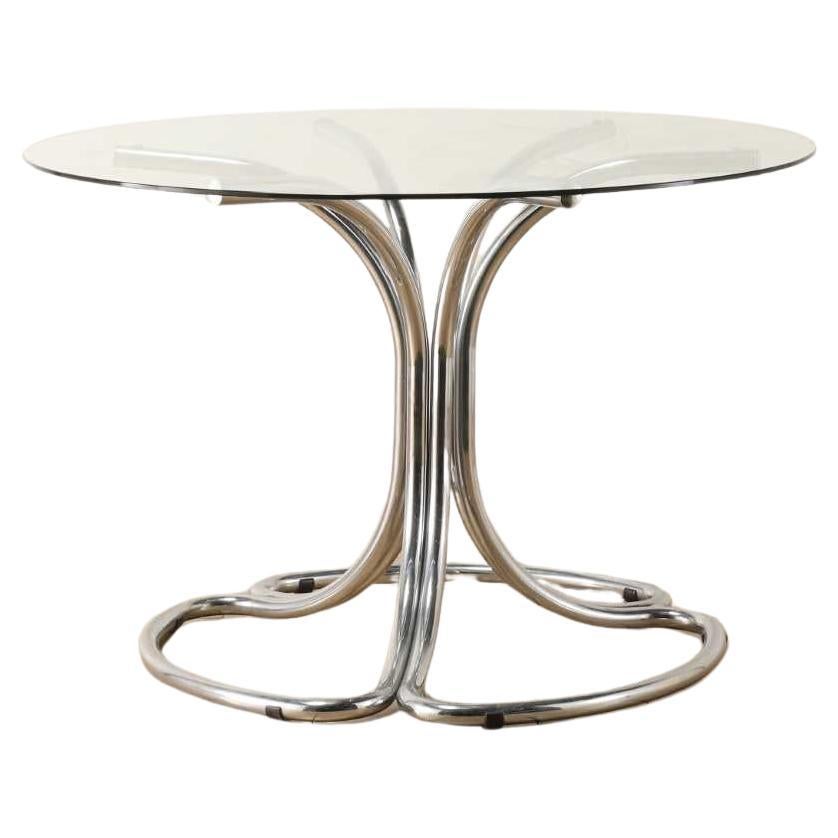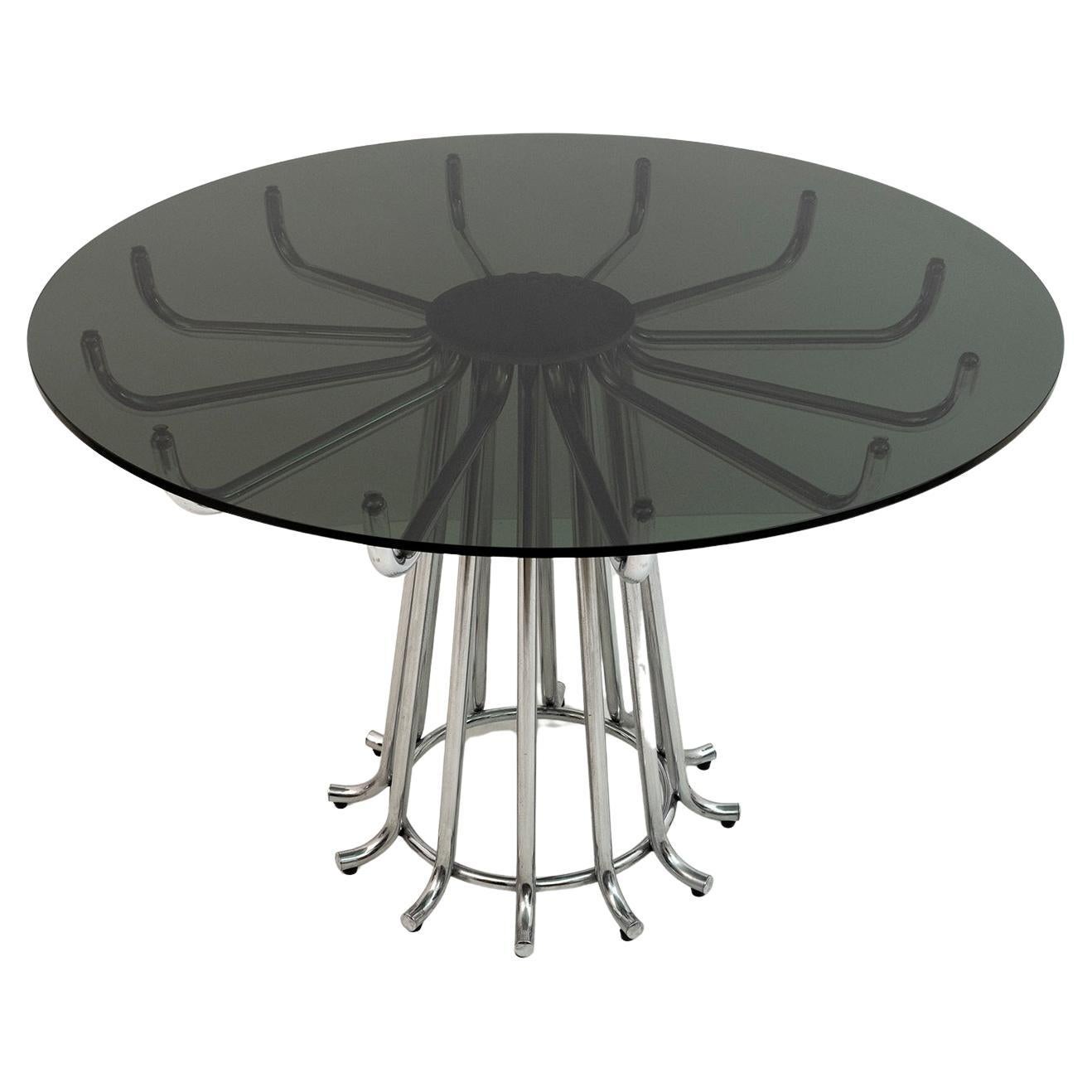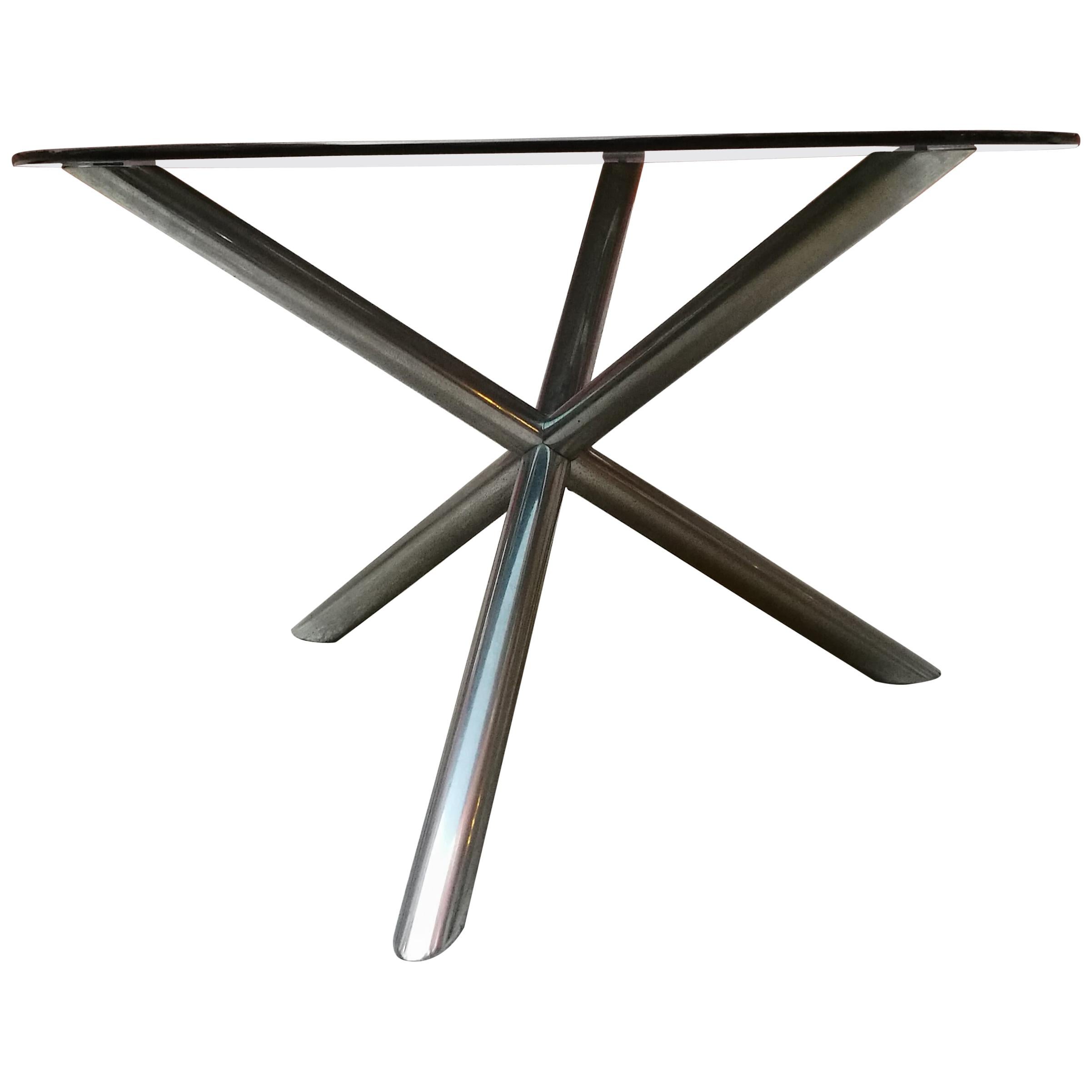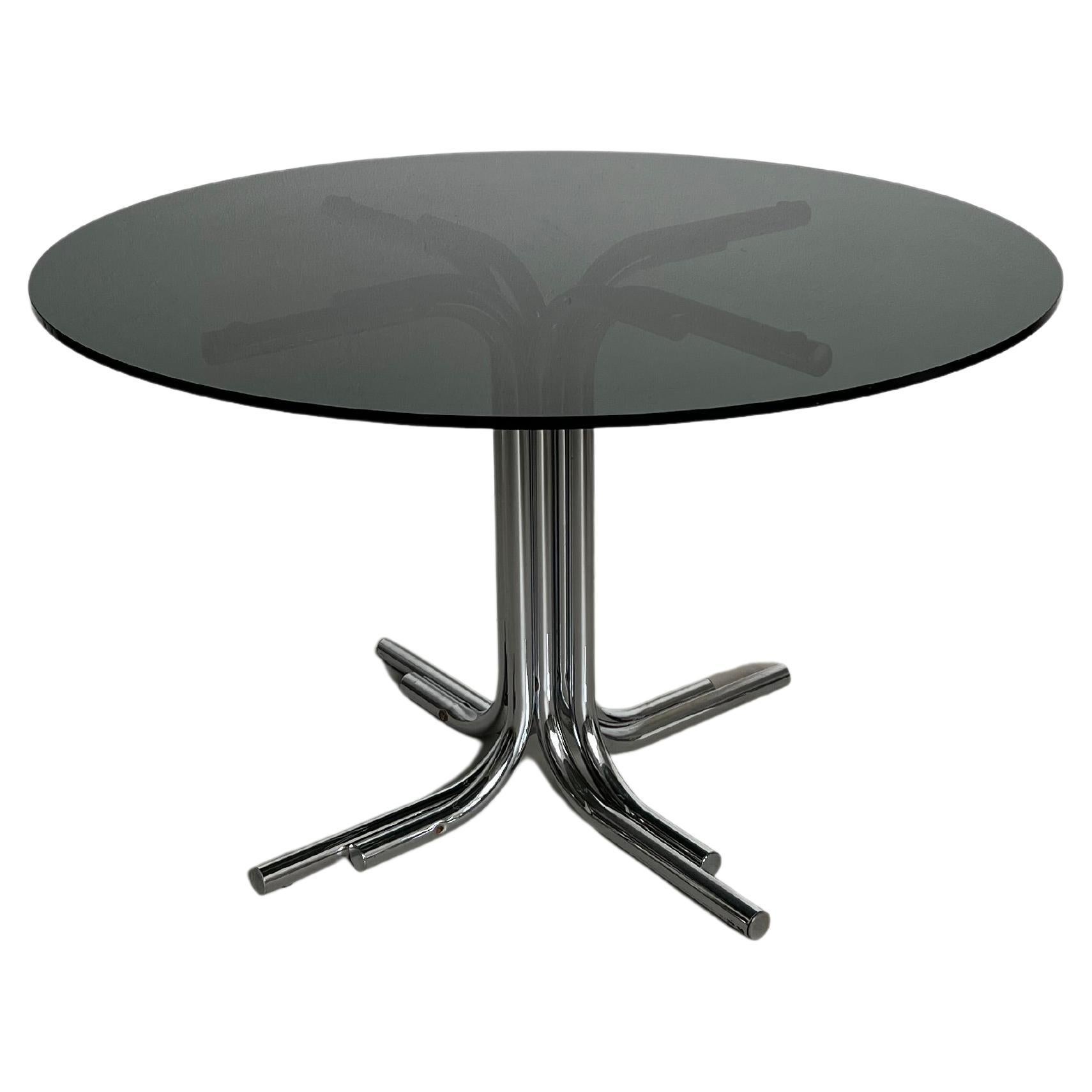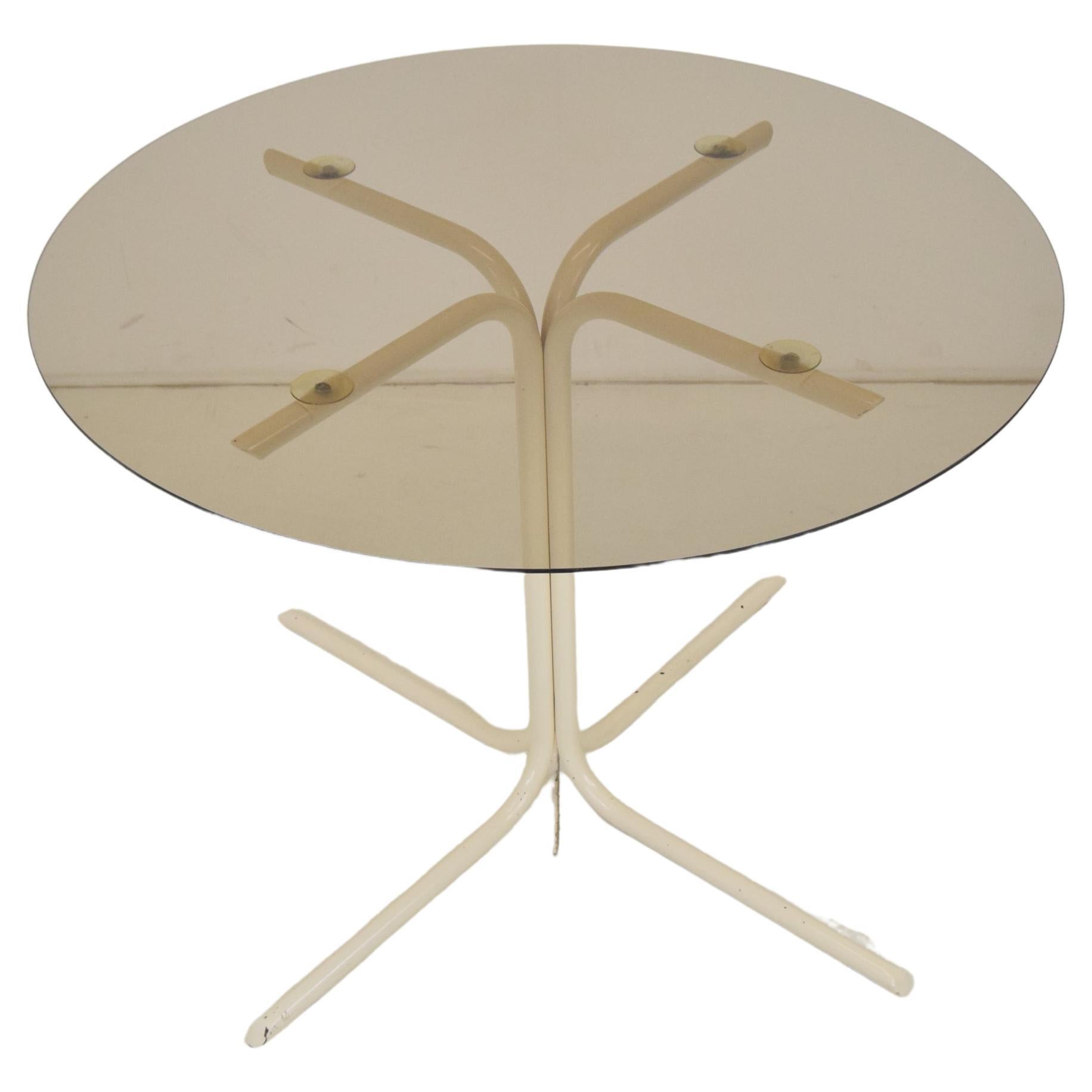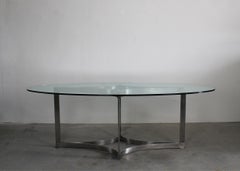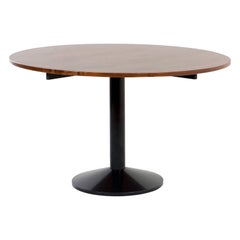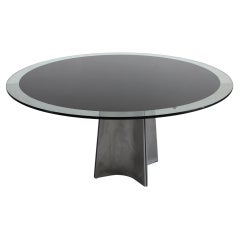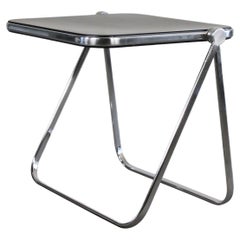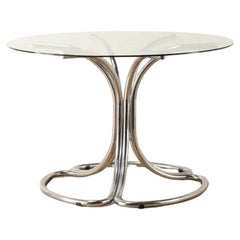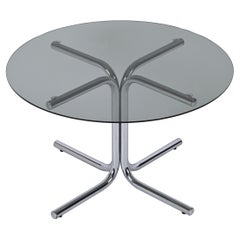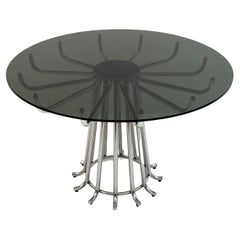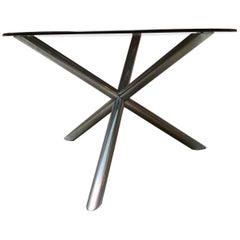Items Similar to Giotto Stoppino Round Dining Table in Steel and Smoked Glass 1970s
Want more images or videos?
Request additional images or videos from the seller
1 of 6
Giotto Stoppino Round Dining Table in Steel and Smoked Glass 1970s
$3,661.27
£2,756.38
€3,100
CA$5,043.65
A$5,648.56
CHF 2,947.33
MX$68,994.79
NOK 37,498.60
SEK 35,346.92
DKK 23,597.62
About the Item
Round dining table with a base in chromed tubular steel and smoked glass on top, designed by Giotto Stoppino, Italian Manufacture from the 1970s.
This table can used as a dining table and also as a centerpiece for a living room.
Giotto Stoppino has been one of the architects that inspired the Neoliberty, the architectural movement that – in the 50s – ruled our country, and that was the answer to the international modernism that, at that time, was extremely popular.
As an architect, Giotto Stoppino signed many projects: buildings, offices, the headquarters of the Banca Popolare di Novara in Bra, textile factories. In Milan, he created buildings in Via Palmanova, Via Cassoni, and Via Desiderio. He had been a member of ADI (Association for Industrial Design) since 1960, he was one of the board members of the association, and he was president from 1982 to 1984. But it’s mostly his projects and his design products that conquered the heart and got engraved in the memory of the Italians (and others), so much that he was nominated for two Compasso d’Oro awards (in 1960 and 1970) and won two Compasso d’oro (in 1979 for the Acerbis’ Sheraton cabinet and in 1991 for Olivari’s Alessia handles). Over the years, the designer worked with some really important Italian and international companies such as Kartell, Rexite, Acerbis, Zanotta, and Driade. And then firms such as Heller New York, Raak Amsterdam, Uchida Tokyo, la Rinascente. Without counting the many Triennale di Milano he took part in, and the exhibition “Italy: The New Domestic Landscape”, which was showcased in the New York’s Museum of Modern Art in 1972 and which is still to this day remembered as one of the most relevant design exhibitions.
Today, the name Giotto Stoppino is linked to two main projects: the 537 Arteluce lamp, exhibited in the New York’s MoMA permanent collection, and the Sheraton cabinet, which can be admired at the London’s Victoria and Albert Museum. The Deda vase, with its sinuous lines and its unique design that is the perfect mix between a spiral and a wedges composition, made the history of design as well. Last but not least, the 4676 magazine rack designed for Kartell: Stoppino was one of the very first designers to use plastic to create his objects, and he owes most of his popularity to Kartell. Which we still hear about.
- Creator:Giotto Stoppino (Designer)
- Dimensions:Height: 29.53 in (75 cm)Diameter: 49.22 in (125 cm)
- Style:Space Age (Of the Period)
- Materials and Techniques:
- Place of Origin:
- Period:
- Date of Manufacture:1970s
- Condition:Wear consistent with age and use.
- Seller Location:Montecatini Terme, IT
- Reference Number:1stDibs: LU5304235285362
About the Seller
4.9
Vetted Professional Seller
Every seller passes strict standards for authenticity and reliability
1stDibs seller since 2020
124 sales on 1stDibs
Typical response time: 1 hour
- ShippingRetrieving quote...Shipping from: Florence, Italy
- Return Policy
Authenticity Guarantee
In the unlikely event there’s an issue with an item’s authenticity, contact us within 1 year for a full refund. DetailsMoney-Back Guarantee
If your item is not as described, is damaged in transit, or does not arrive, contact us within 7 days for a full refund. Details24-Hour Cancellation
You have a 24-hour grace period in which to reconsider your purchase, with no questions asked.Vetted Professional Sellers
Our world-class sellers must adhere to strict standards for service and quality, maintaining the integrity of our listings.Price-Match Guarantee
If you find that a seller listed the same item for a lower price elsewhere, we’ll match it.Trusted Global Delivery
Our best-in-class carrier network provides specialized shipping options worldwide, including custom delivery.More From This Seller
View AllVittorio Introini Oval Shaped Dining Table in Steel ang Glass by Saporiti 1970s
By Saporiti, Vittorio Introini
Located in Montecatini Terme, IT
Dining table with a beautiful base in steel and top in thick glass, designed by Vittorio Introini and manufactured by Saporiti in the 1970s.
The table present an elegant and beautif...
Category
Vintage 1970s Italian Post-Modern Dining Room Tables
Materials
Steel
Franco Albini TL30 Round Table in Metal and Wood by Poggi 1950s
By Poggi, Franco Albini
Located in Montecatini Terme, IT
TL30 table with a round top in wood and a base in black lacquered metal, designed by Franco Albini and produced by Poggi in the 1950s.
After spending his childhood and part of his youth in Robbiate in Brianza, where he was born in 1905, Franco Albini moved with his family to Milan. Here he enrolled in the Faculty of Architecture of the Polytechnic and graduated in 1929. He starts his professional activity in the studio of Gio Ponti and Emilio Lancia, with whom he collaborates for three years. He probably had his first international contacts here
In those three years, the works carried out are admittedly of a twentieth-century imprint. It was the meeting with Edoardo Persico that marked a clear turning point towards rationalism and the rapprochement with the group of editors of “Casabella”.
The new phase that that meeting provoked starts with the opening of the first professional studio in via Panizza with Renato Camus and Giancarlo Palanti. The group of architects began to deal with public housing by participating in the competition for the Baracca neighborhood in San Siro in 1932 and then creating the Ifacp neighborhoods: Fabio Filzi (1936/38), Gabriele D’Annunzio and Ettore Ponti (1939).
Also in those years Albini worked on his first villa Pestarini.
But it is above all in the context of the exhibitions that the Milanese master experiments his compromise between that “rigor and poetic fantasy” coining the elements that will be a recurring theme in all the declinations of his work – architecture, interiors, design pieces . The opening in 1933 of the new headquarters of the Triennale in Milan, in the Palazzo dell’Arte, becomes an important opportunity to express the strong innovative character of rationalist thought, a gym in which to freely experiment with new materials and new solutions, but above all a “method”.
Together with Giancarlo Palanti, Albini on the occasion of the V Triennale di Milano sets up the steel structure house, for which he also designs the ‘furniture. At the subsequent Triennale of 1936, marked by the untimely death of Persico, together with a group of young designers gathered by Pagano in the previous edition of 1933, Franco Albini takes care of the preparation of the exhibition of the house, in which the furniture of three types of accommodation. The staging of Stanza per un uomo, at that same Triennale, allows us to understand the acute and ironic approach that is part of Albini, as a man and as a designer: the theme addressed is that of the existenzminimum and the reference of the project is to the fascist myth of the athletic and sporty man, but it is also a way to reflect on low-cost housing, the reduction of surfaces to a minimum and respect for the way of living.
In that same year Albini and Romano designed the Ancient Italian Goldsmith’s Exhibition: vertical uprights, simple linear rods, design the space. A theme, that of the “flagpole”, which seems to be the center of the evolution of his production and creative process. The concept is reworked over time, with the technique of decomposition and recomposition typical of Albinian planning: in the setting up of the Scipio Exhibition and of contemporary drawings (1941) the tapered flagpoles, on which the paintings and display cases are hung, are supported by a grid of steel cables; in the Vanzetti stand (1942) they take on the V shape; in the Olivetti store in Paris (1956) the uprights in polished mahogany support the shelves for displaying typewriters and calculators. The reflection on this theme arises from the desire to interpret the architectural space, to read it through the use of a grid, to introduce the third dimension, the vertical one, while maintaining a sense of lightness and transparency.
The flagpole is found, however, also in areas other than the exhibition ones. In the apartments he designed, it is used as a pivot on which the paintings can be suspended and rotated to allow different points of view, but at the same time as an element capable of dividing spaces. The Veliero bookcase...
Category
Vintage 1950s Italian Mid-Century Modern Tables
Materials
Metal
Luigi Saccardo UFO Pedestal Table in Steel and Glass by Maison Jansen 1970s
By Luigi Saccardo, Maison Jansen
Located in Montecatini Terme, IT
Round pedestal dining table model UFO with a base in brushed steel and tabletop in thick glass with a black enamel decorative circle.
Designed by Luigi Saccardo and manufactured by Maison Jansen in the 1970s.
Maison Jansen was a Paris-based interior decoration office founded in 1880 by Dutch-born Jean-Henri Jansen.
From its beginnings, Maison Jansen combined traditional furnishings with influences of new trends including Anglo-Japanese style, the Arts and Crafts movement, and Turkish style. The firm paid great attention to historical research with which it attempted to balance clients' desires for livable, usable, and often dramatic space. Within ten years the firm had become a major purchaser of European antiques, and by 1890 had established an antique gallery as a separate firm that acquired and sold antiques to Jansen's clients and its competitors as well.
In the early 1920s Jean-Henri Jansen approached Stéphane Boudin, who was then working in the textile trimming business owned by his father and brought him on board. Accounts of the arrangement vary. Speculation existed that Boudin was able to provide financial solvency to the prominent but capital-poor atelier. Boudin's attention to detail, concern for historical accuracy, and ability to create dramatic and memorable spaces brought increasing new work to the firm. Boudin was made director and presided over an expansion of the firm's offices and income.
Not originally equipped with its own workrooms for producing furniture the firm began by relying upon antiques and the furniture contracted to outside cabinetmakers. By the early 1890s Maison Jansen had established its own manufacturing capacity producing furniture of contemporary design, as well as reproductions, primarily in the Louis XIV, Louis XVI, Directoire, and Empire styles.
Throughout the firm's history, it employed a traditional style drawing upon European design, but influence of contemporary trends including the Vienna Secession, Modernism, and Art Deco has also appeared in Jansen interiors and in much of the custom furniture the firm produced between 1920 and 1950.
Under Boudin's leadership, Maison Jansen provided services to the royal families of Belgium, Iran, and Serbia; Elsie de Wolfe, and Lady Olive Baillie's Leeds Castle...
Category
Vintage 1970s French Mid-Century Modern Pedestals
Materials
Iron, Steel
Giancarlo Piretti Platone Folding Table in Steel and Black Polyurethane 1970s
By Anonima Castelli, Giancarlo Piretti
Located in Montecatini Terme, IT
Platone folding table or desk with structure in chromed steel and die-cast aluminum, table top in black ABS.
Designed by Giancarlo Piretti and produced b...
Category
Vintage 1970s Italian Post-Modern Tables
Materials
Aluminum, Steel
Mario Bellini La Rotonda Round Table in Walnut Wood by Cassina 1980s
By Cassina, Mario Bellini
Located in Montecatini Terme, IT
La Rotonda round-shaped table in walnut wood, designed by Mario Bellini in 1976 and produced by Cassina.
La Rotonda table is an exquisite fusion of ...
Category
Vintage 1970s Italian Mid-Century Modern Tables
Materials
Walnut
Ettore Sottsass T72 Round Table in Wood and Brass by Poltronova 1950s
By Ettore Sottsass, Poltronova
Located in Montecatini Terme, IT
Round table model T72 in wood, black lacquered metal and brass details, designed by Ettore Sottsass and produced by Poltronova in the late 1950s.
The T72 table has a strong base mad...
Category
Vintage 1950s Italian Mid-Century Modern Dining Room Tables
Materials
Metal, Brass
You May Also Like
Giotto Stoppino Glass Top Chrome Round Table 1970's
By Giotto Stoppino
Located in Shibuya-ku, 13
This stunning glass-top table is a creation by renowned Italian designer Giotto Stoppino, celebrated for his bold and forward-thinking approach to modern design.
The table’s distinct...
Category
Vintage 1970s Italian Mid-Century Modern Dining Room Tables
Materials
Chrome
Chrome and Smoked Glass Round Italian Coffee Table, Giotto Stoppino Style, 1970s
By Giotto Stoppino
Located in Roma, IT
Beautiful coffee table in chromed metal with smoked glass top. This lovely table was designed in Italy in the 1970s in the style of Giotto Stoppino.
This charming round table featur...
Category
Vintage 1970s Italian Mid-Century Modern Coffee and Cocktail Tables
Materials
Metal, Chrome
Gastone Rinaldi Mid-Century Modern Italian Chromed Metal Round Dining Table, 70s
By Gastone Rinaldi
Located in Puglia, Puglia
Tavolo Mid-Century base a stella cromato con piano tondo in vetro fumè disegnato da Gastone Rinaldi. Cromo in buone condizioni. Spettacolare tavolo da pranzo...
Category
Vintage 1970s Italian Mid-Century Modern Dining Room Tables
Materials
Chrome
$2,314 Sale Price
30% Off
Italian Round Smoked Glass and Chromed Steel Dining Table, 1970s
Located in MIlano, IT
Italian round smoked glass and chromed steel dining table, 1970s
Elegant and modern round dining table with smoked glass top and massive chromed ste...
Category
Vintage 1970s Italian Mid-Century Modern Dining Room Tables
Materials
Steel
Vintage Italian Space Age Dining Table with Chromed Legs and Smoked Glass Top
By Giotto Stoppino
Located in Milano, IT
Offered for sale is a stunning and timeless Space Age dining table, with tubular legs in chromed metal and a round smoked glass top with squared edge. Designed and manufactured most ...
Category
Vintage 1970s Italian Space Age Dining Room Tables
Materials
Metal, Steel, Chrome
$1,866 Sale Price
20% Off
Round Dining Table, Metal and Glass, 1970's
Located in Praha, CZ
Made in Czechoslovakia
Made of Glass,Metal
With aged patina
Re-polished
Good original condition.
Category
Vintage 1970s Czech Mid-Century Modern Dining Room Tables
Materials
Metal
$557 Sale Price
20% Off
More Ways To Browse
Kartell Top Top
Kartell 1970s
Kartell Table Vintage
Heller Italian
Italian Flip Top Table
Lane Walnut Dining Room Table
Mid Century Modern Gate Leg Table
Newton Boca Do Lobo
Pacini And Cappellini
Refractory Dining Table
Thomasville Dining Table Used
Wiggle Table
10ft Dining Table
Antique Shoe Stretcher
Dining Tisch
Lato Table
Live Edge Bronze Dining Table
Long Narrow Dining Tables
